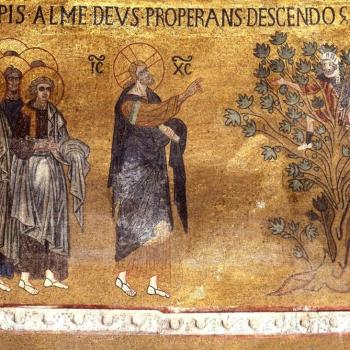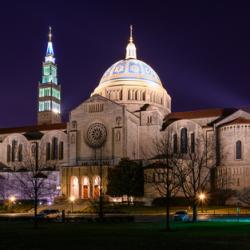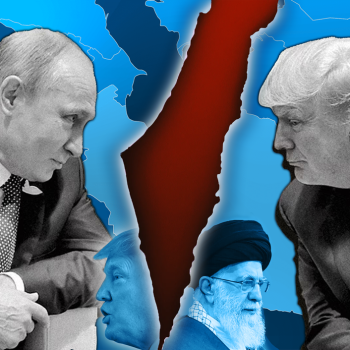A House Divided begins where American Zion left off. Joshua has left Missouri to turn over a new leaf as witnessed by his stately ponytail, groomed whiskers, and clean chin. This dramatic change in appearance suddenly grants him a slew of new abilities, such as politeness, erect posture, educated speech, and polished manners. However, Joshua's return to Missouri and the evils of old is accompanied by ungathered hair and facial scruff. Joshua is later made a captain in the Missouri militia by mutton-chopped Governor Boggs (another example of the evil beard giving way to historical detail). Joshua is joined in his new post by several bearded others, including the primary face of his antagonist, Bobby Johnson (Michael Bowen). On one occasion, clean-shaven Mormons even defy him, which leads to tar-and-feathering.
In the film's (and trilogy's) climax, Joshua rides out to stop the mob from descending upon his encamped family. After diffusing the situation, Joshua turns his back on Bobby, giving the latter an opening to attack. Unable to save himself in time, Joshua is rescued by Nathan, who shoots and kills Bobby. The facial hair motif in play throughout the series underscores the dynamic of good and evil perfectly in this scene. Being bearded himself, Joshua is unable to save himself by killing Bobby. Had he done so, his beard would have translated it into an act of evil. But Nathan, righteous by virtue of beardlessness saves him. Joshua conquers Bobby through the proxy of clean-shaven Nathan, thus saving himself from shedding blood while bearded.
The "evil beard" features just as prominently in the film's other subplots. Bearded and mustachioed detractors torment Joseph after the collapse of the Kirtland Safety Society Bank, including his brother William and golden plate witness David Whitmer. Note the return of the venerable beard as well, this time exempted for its Rabbinic significance during an attack on Joseph's house as it is more conventionally symbolic of the bearer's faith, not his failings. On the other hand, Ben and Nathan return to their clean-shaven ways, their previous temptations now behind them, culminating in Ben's baptism.
One final scene is critical to the examination. As a group of weary pioneers (including Jesse) trek back into Missouri, they are met by a band of bearded men on horseback. The tension is palpable in the faces of the pioneers as the band approaches, even though the only really dubious aspect about them is their facial hair. A great sigh of relief goes up when it's revealed that the band is actually a Mormon delegation sent to welcome and assist the beleaguered immigrants. In this case, facial hair is not symbolic of evil personified, but rather, evil perceived. The filmmakers use their own convention to manipulate audience expectation.
Ultimately, the question is "why?" Is the "evil beard" a stereotype as Holt intimates? Specifically, why is this a stereotype, and if so, why is it being perpetuated, consciously or otherwise? How does a religious audience reconcile the prevalence of the evil beard within a major motion picture when that religion's own deities are universally depicted as being bearded? At the very least, one can argue that the filmmakers simply made the choice to create a visual motif to underline certain thematics at work within the film. The problem with this argument is that in many instances within the films, facial hair didn't merely underline depictions of evil, it replaced them. More troubling still is the notion that it did so as part of a stereotype in action.
Financeers, producers, and publishers all promised a film of utmost quality. And it's very possible that the professional look and diegetic content of the finished product have merited that distinction. However, while those considerations may outweigh the perpetuation of the "evil beard," they do not disguise it. It seems significant that The Work and the Glory series has created a symbol of evil not based in Mormon doctrine, but Mormon culture, specifically, Mormon missionary culture.
It is not the purpose of this criticism to postulate whether this is good or bad, but rather, to simply point out that it is. And that it is leads to this final question: Why would the translation of the most beloved fiction of the LDS faith to an audio/visual medium require that its portrayal of evil be reinforced or replaced by a cultural stereotype, especially when that translation was intended for the exact same audience?
Eric Thompson blogs at A Motley Vision, devoted to examining Mormon arts and culture, where this first appeared.




